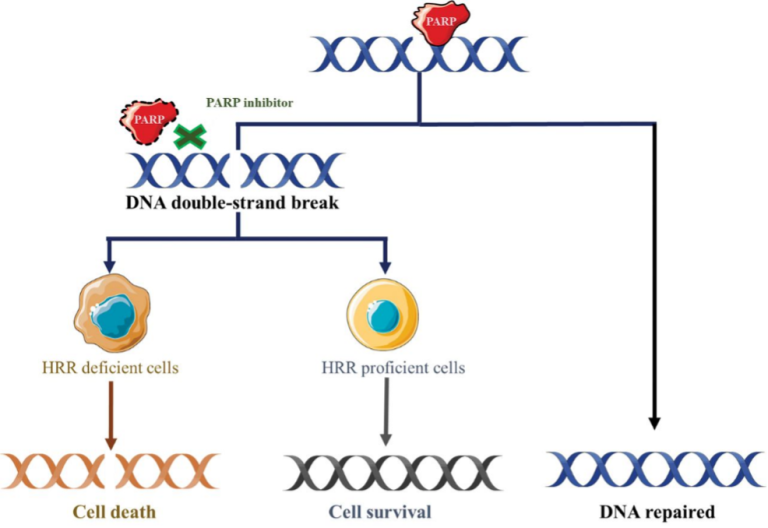Homologous recombination repair (HRR)
HRR is a type of repair mechanism widely used by cells to accurately repair harmful DNA breaks that occur on both strands of DNA, known as double-stranded breaks. HRR uses a sister chromatid as a template for accurate repair and is crucial in preventing accumulation of genetic abnormalities that can cause cancer.
Homologous recombination deficiency (HRD)
HRD is defined by the inability of cells to effectively repair double-stranded breaks via HRR. This can happen when the genes involved in HRR pathway have mutations, and have been associated with various cancers such as high-grade serous ovarian cancer, triple-negative breast cancer, metastatic castration resistant prostate cancer and pancreatic ductal adenocarcinoma. While HRD is mostly due to mutations in BRCA1 and BRCA2, mutations in other genes such as ATM, BARD1, CHEK2, PALB2 and RAD51 are also known to give rise to HRD.
Assessing HRD
Not all tumors are HRD-positive. HRD status can be assessed via 2 different types of biomarkers: individual mutations in the genes involved in HRR pathway, and genomic instability markers such as loss of heterozygosity (LOH), telomeric allelic imbalance (TAI), and large-scale state transitions (LSTs). A HRD score is calculated based on one or multiple HRD biomarkers using a proprietary lab-specific algorithm to determine HRD status. Comprehensive genomic profiling (CGP) is an approach that uses a single next-generation sequencing (NGS) assay to assess hundreds of genes for relevant cancer biomarkers (including genes involved in HRR pathway) and genomic signature such as HRD, tumor mutational burden (TMB) and microsatellite instability (MSI). It is worth noting that genomic instability markers used to determine HRD status is distinct from TMB, MSI and PD-1/PD-L1 expression.
Benefit of HRD testing
Determination of HRD status in tumors is important in guiding treatment decisions, particularly in the selection of targeted therapies like PARP inhibitors. PARP inhibitors work by blocking the action of the PARP enzyme in cancer cells to inhibit DNA repairs, leading to death of cancer cells. Thus, using PARP inhibitors in HRD-positive tumors can potentially improve patient outcomes. PARP inhibitors such as olaparib, niraparib, rucaparib and talazoparib have been approved by the U.S. FDA for HRD-positive ovarian, breast, prostate and pancreatic cancer.

Canary Oncoceutics has a steadfast commitment to three fundamental pillars: advancing scientific knowledge, fostering collaboration, and ultimately, enhancing the lives of cancer patients worldwide. From cutting-edge research to impactful clinical advancements, Canary Oncoceutics aims to illuminate the transformative potential of tailored cancer treatments. Join us on this journey towards a future where every cancer patient receives personalized, effective treatment tailored to their unique needs.